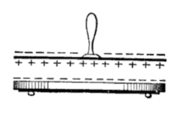
Electrophorus
Encyclopedia

Capacitor
A capacitor is a passive two-terminal electrical component used to store energy in an electric field. The forms of practical capacitors vary widely, but all contain at least two electrical conductors separated by a dielectric ; for example, one common construction consists of metal foils separated...
generator used to produce electrostatic charge via the process of electrostatic induction
Electrostatic induction
Electrostatic induction is a redistribution of electrical charge in an object, caused by the influence of nearby charges. Induction was discovered by British scientist John Canton in 1753 and Swedish professor Johan Carl Wilcke in 1762. Electrostatic generators, such as the Wimshurst machine, the...
. A first version of it was invented in 1762 by Swedish professor Johan Carl Wilcke,
but Italian scientist Alessandro Volta
Alessandro Volta
Count Alessandro Giuseppe Antonio Anastasio Gerolamo Umberto Volta was a Lombard physicist known especially for the invention of the battery in 1800.-Early life and works:...
improved and popularized the device in 1775, and is sometimes erroneously credited with its invention.
The word electrophorus was coined by Volta from the Greek ήλεκτρον ('elektron'), ϕέρω ('phero'), meaning 'electricity bearer'.
Description and operation
The electrophorus consists of a dielectricDielectric
A dielectric is an electrical insulator that can be polarized by an applied electric field. When a dielectric is placed in an electric field, electric charges do not flow through the material, as in a conductor, but only slightly shift from their average equilibrium positions causing dielectric...
plate (originally a 'cake' of resinous material like pitch or wax, but in modern versions plastic is used) and a metal plate with an insulating handle. First, the dielectric plate is charged through the triboelectric effect
Triboelectric effect
The triboelectric effect is a type of contact electrification in which certain materials become electrically charged after they come into contact with another different material and are then separated...
by rubbing it with fur or cloth. For this discussion, imagine the dielectric gains negative charge by rubbing, as in the illustration below. Then, the metal plate is placed onto the dielectric plate. The dielectric does not transfer a significant fraction of its surface charge to the metal because the microscopic contact is poor. Instead the electrostatic field of the charged dielectric causes the charges in the metal plate to separate. It develops two regions of charge — the positive charges in the plate are attracted to the side facing down toward the dielectric, charging it positively, while the negative charges are repelled to the side facing up, charging it negatively, with the plate remaining electrically neutral as a whole. Then, the side facing up is momentarily grounded (which can be done by touching it with a finger), draining off the negative charge. Finally, the metal plate, now carrying only one sign of charge (positive in our example), is lifted.

One of the largest examples of an electrophorus was built in 1777 by German scientist Georg Christoph Lichtenberg
Georg Christoph Lichtenberg
Georg Christoph Lichtenberg was a German scientist, satirist and Anglophile. As a scientist, he was the first to hold a professorship explicitly dedicated to experimental physics in Germany...
. It was 6 feet (2 m) in diameter, with the metal plate raised and lowered using a pulley system. It could reportedly produce 15 inch (38 cm) sparks. Lichtenberg used its discharges to create the strange treelike marks known as Lichtenberg figure
Lichtenberg figure
Lichtenberg figures are branching electric discharges that sometimes appear on the surface or the interior of insulating materials. They are named after the German physicist Georg Christoph Lichtenberg, who originally discovered and studied them...
s.
The source of the charge
Charge in the universe is conserved. The electrophorus simply separates positive and negative charges. A positive or negative charge ends up on the metal plate (or other storage conductor), and the opposite charge is stored in another object after grounding (in the earth or the person touching the metal plate). This separation takes workMechanical work
In physics, work is a scalar quantity that can be described as the product of a force times the distance through which it acts, and it is called the work of the force. Only the component of a force in the direction of the movement of its point of application does work...
since the lowest energy state implies uncharged objects. Work is done by raising the charged metal plate away from the oppositely charged resinous plate. This additional energy put into the system is converted to potential energy
Electric potential energy
Electric potential energy, or electrostatic potential energy, is a potential energy that results from conservative Coulomb forces and is associated with the configuration of a particular set of point charges within a defined system...
in the form of charge separation (opposite charges that were originally on the plate), so raising the metal plate actually increases its voltage relative to the dielectic plate.
The electrophorus is thus actually a manually operated electrostatic generator, using the same principle of electrostatic induction
Electrostatic induction
Electrostatic induction is a redistribution of electrical charge in an object, caused by the influence of nearby charges. Induction was discovered by British scientist John Canton in 1753 and Swedish professor Johan Carl Wilcke in 1762. Electrostatic generators, such as the Wimshurst machine, the...
as electrostatic machines such as the Wimshurst machine
Wimshurst machine
The Wimshurst influence machine is an electrostatic generator, a machine for generating high voltages developed between 1880 and 1883 by British inventor James Wimshurst ....
and the Van de Graaf generator.

